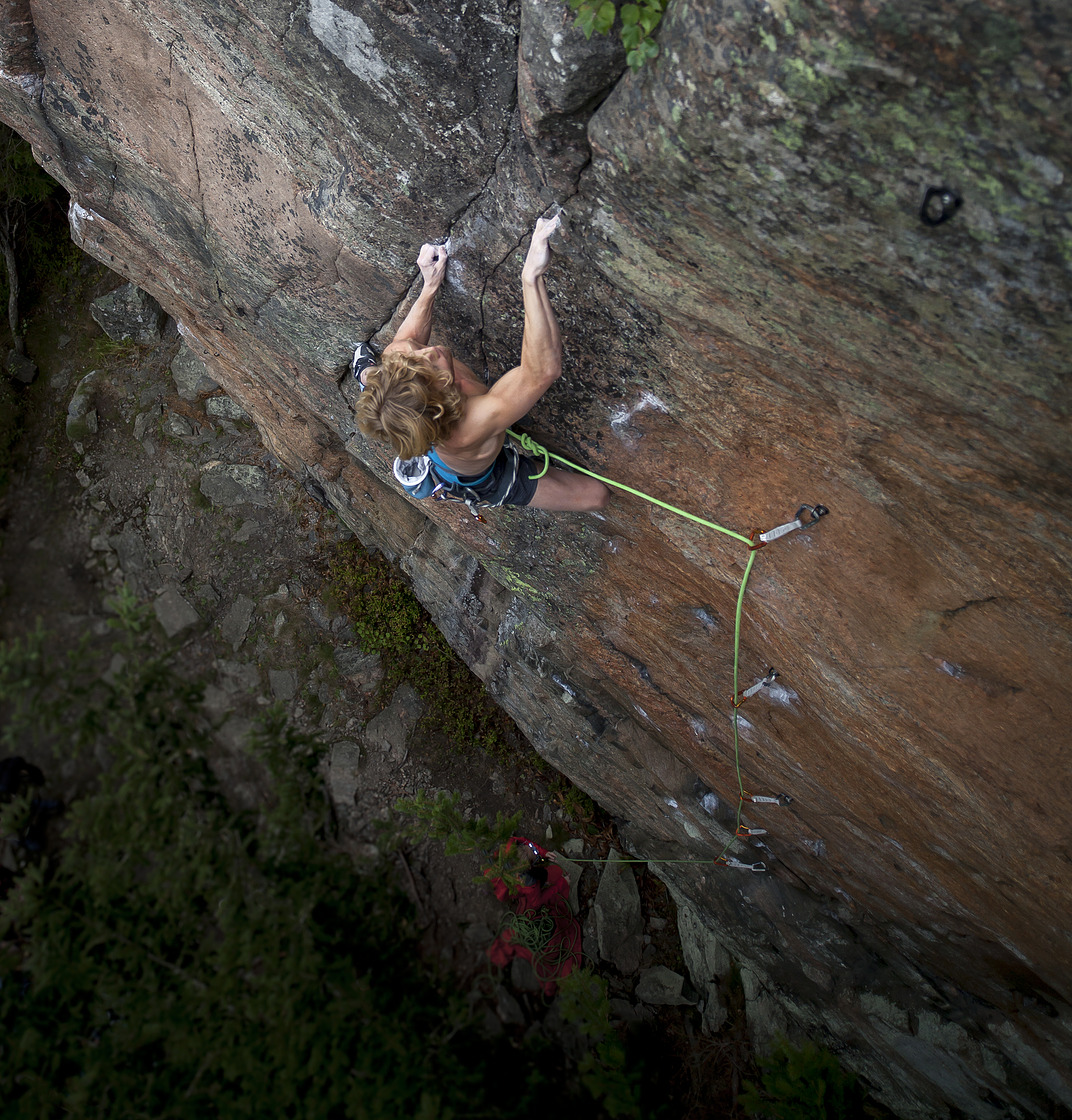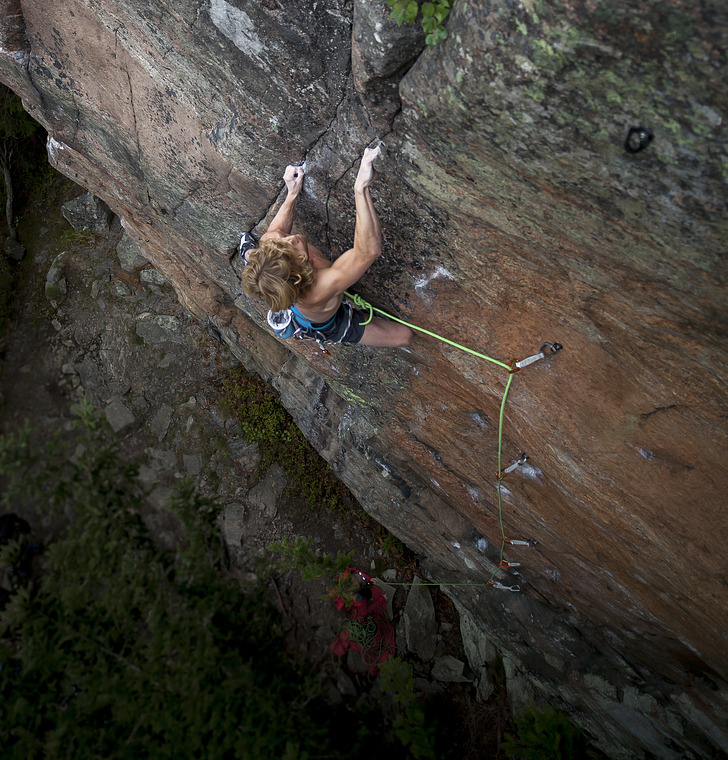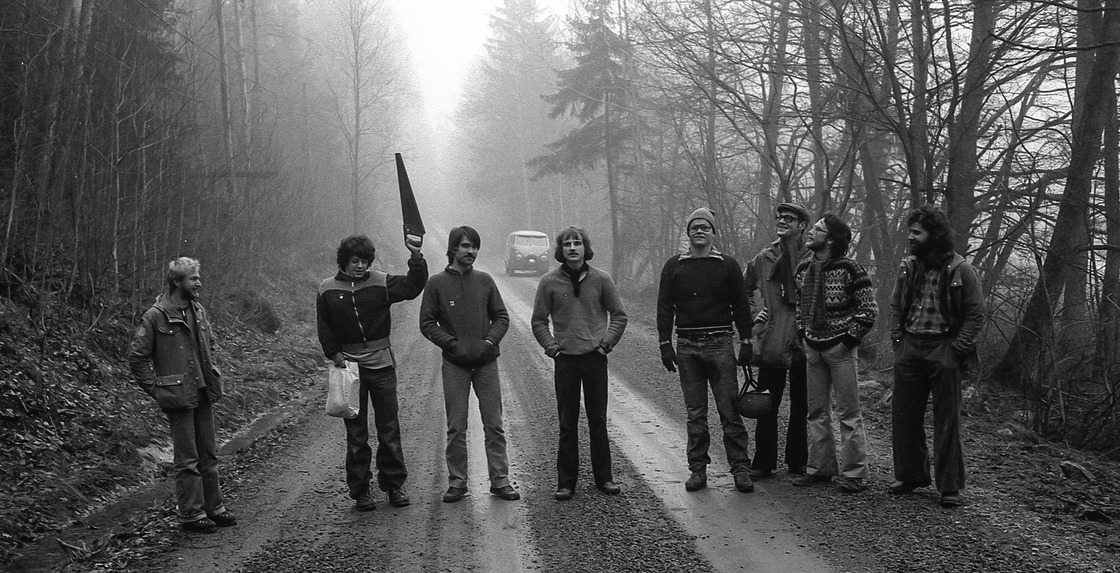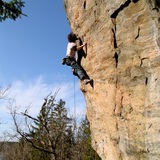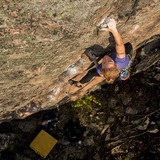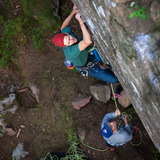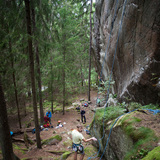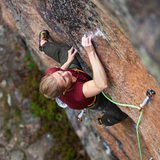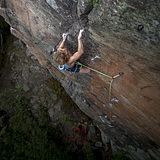At the far end of the Tyresö Peninsula is this twenty-meter-high and five-hundred-meter-long wall. This is perhaps Stockholm's longest and highest-quality continuous wall. The crag is located along a gravel road but is hidden uphill behind trees, and you have to get right next to the wall to realise its greatness and fine quality. The scenery from the top is terrific, but at the base grows a fairly dense forest that blocks all views.
For the serious traditional climber, several fine, demanding and even epoch-making "masterpieces" are offered. If you prefer sport, there is plenty to do as well, but there is not that much to offer in the lower grades.
The two most popular walls are Apocalypse and Lord hård-wall, which are frequently visited walls with several fine, both completely bolted and naturally protected classics. Some of the routes on these two walls have been renovated. Some bolted quite hard routes have just recently also been developed on “No more heroes-wall”, which is good as it can become quite “crowded” around the relatively few and hard routes at Apocalypsväggen. The most impressive sector is Lord Hård-wall. This wavy steep and rather high wall with clean-looking crack lines is one of the most delicious in Stockholm. And I would say it's the first-hand choice if this is your first visit to Dyviksudd. Here are also a couple of well bolted easier routes off high class. The naturally protected routes on Lord Hård are demanding but are among the absolute best in Stockholm.
The first section on Gibbon-partiet offers some steep overhanging short routes that are fun but pretty loose. Rock quality becomes better and less steep to the right on the wall. The section around the Stockholm classic Maja (6a) is nice and offers some naturally protected routes between 6a-6b that are great and they have also been newly brushed. Quite many of the routes in this sector are equipped with some pitons or old bolts here and there. These are in pretty bad shape and should probably be backed up. There is only one route with modern bolts in this sector (Clawfinger, 7c). The route Maja is located straight up from the parking.
Kokoskorvs-väggen is located quite pleasantly and offers some pretty nice and demanding traditional or mixed vertical climbs around 6a+ to 6c. If renovated and brushed, I would recommend this sector.
No more heroes-wall: The longest continuous sector on Dyviksudd. This is a surprisingly impressive wall with big bulky overhangs and different striking formations and cracks which often turn into a less steep wall higher up on the face. The rock quality is good or excellent. Has got a couple of new bolted very nice sport routes and some of the older routes have also been renovated. The new and renovated routes are in good shape, of course, the older routes are often quite mossy and the pitons and bolts are old and outdated. Alongside Lord Hård and Apocalypse-wall this sector is highly recommended to any driven and skilful climber.
If you want to bring your kids, Lord Hård-väggen is your best option.
Environment: West Facing. Trees are in front of the wall everywhere, but the face is more open to the sun the higher up on the wall you get. Lord Hård-Wall is facing southwest. Beautiful view from the top, but at the base of the crag trees obscure and often block all views.
By Claes Jelinek
Gillis Billing was here already in the 30s and reconnoitered but the rocks were forsaken for some unknown reason. Maybe it was too difficult to get out here at that time? It was not until the 1970s that the realization of the concentration of rocks and the opportunities that existed out here began to sink into the consciousness of mountaineers.
In 1974, Torbjörn Berg and Kenth Lindström made the future classic Maja at Dyviksudd and during the late '70s, the talented Christer Åstrand ravaged the crag and created several futuristic creations; Gibbon, Fingerkroken, Alpinisten and as the crown of the work; the metaphysical attraction Apocalypse, which proved to be commensurate with evil in its purest form.
Jeremy Sheehan, a polite Englishman with a weakness for malt drinks, cigars and difficult free climbing, opened No more heroes with Svadängs in 1982. In the years that followed, interest increased and leads such as Orgier på personaltoaletten, Kokoskorven, Brutal konfekt och Dyrbar fritid were produced. For some reason, strikingly many notables managed to psyche out at Dyrbar fritids crux and then be rescued by bullying comrades. The 80s were without a doubt the most eventful period in terms of the purely sporting development of the sport of climbing and then, as now, there were people with completely different levels of ambition. A group used to sit in a bush on top of a crag and drink alcohol after completing the climb. Then the bus entered and after a very good half hour with decelerations, turns and old aunts and uncles who would occasionally put the backfill in with violent force. Once in town, it was the straight track to the nearest pub that mattered. Others who were insanely serious and ascetic in their disposition consumed their muesli with water, skipped lunch and ended with a particularly spartan evening meal.
Swedish climbing history was written at Dyvik during the 80s and several of the routes that were made then are important milestones in the performance progression of the Swedish climbing sport.
Eva Selin made Good dag yxskaft in 1984 and opened the difficult Mamma mia already in 1986. Anders Lundahl did Lord Hård in 1984 and the following year the mixed protected Kilroy was made which became Scandinavia's first 8+. The first known pure clean ascent of this route was made by the competent Fredrik Rundkvist many years later. Rikard Hedman became the first Swede to climb 8a (Swedish 9-) when in 1988 he managed to tear himself up for Reve d'un Papillon in Buoux in southern France. According to Johan Luhr, the combination route Zorro became Sweden's first 9-. It starts with Lundahls Reptilen (8+) and ends with Johan and Rikards Kosmos kid (8+). Despite the fact that Eva and Anders have had the most new routes made, many other climbers have contributed to the development of the crag. Daniel Bidners Mina kulor - din haka (8), 1000 punxs (A4), Skola – arbete – död (7/7 +) and Bidrags – Jesus (min bäste vän) (6 + / 7-) both represent subtle sharpness in the naming of the routes and divergent climbing styles. Erik Massih, one of Sweden's absolute best all-round climbers, also made a couple of new ascents a couple of years ago.
Aid climbing has been conducted as a completely separate activity on this crag; Kalle Persson, Thomas Heide, Sven Blom and Bertil Holmberg started the business in the early 80's and since then new lines have been added at irregular intervals by various climbers. An evening paper's leaflet was given the name of Guillou låter sektledaren piska kvinna i TV (A3). Stefan Wulf managed to climb this route in the autumn of 2007. Stefan is a leading figure among the handful of climbers in Sweden who sometimes engage in classic sparsely protected climbing of a very high degree of difficulty. This climbing genre - which is definitely not for everyone - combines both traditional values and environmental thinking and can be said to be the epitome of the perfect climbing achievement. All basic components are represented; technical equilibrium, physical fitness and above all; enormous demands on mental control. In this age of standardization and regulation, this style is an interesting and important opposite, but as I said; it really can not be recommended to the common man. In 1990, Harri Sporrevik brushed off some nice and toxic rides on the small wall to the right of Lord Hård's wall. The name of the Avskaffa paragraf fetma referred to a clause in the weight loss agreement drawn up between Harri and his currently somewhat overweight lady.
The crag has now again come into the spotlight, and some of Stockholm's most talented sports climbers have begun to discover the cliff's potential for challenging sport climbing routes. Scott Mooney made the great bouldery route I Scottlinjen (8b +), and Stefan Petersson managed in 2019 to free climb the old AID-route "A bunch of angels and some other shit" (A1+), a striking overhanging crackline. There are also some very nice newly made routes done by Tiziano Buccella, Iain Pitcairn, Rasmus Johansson, Nils Winell, Robin Dahlberg, and Viktor Gyllenberg. Most of the new routes are made south of Apocalyps wall outside the nature reserve boundary. The old mixed routes inside the nature reserve are still waiting to be fixed (with permission from the municipality).
